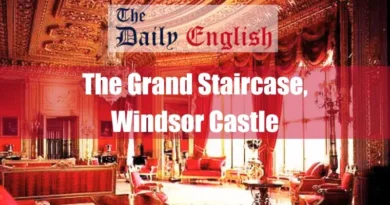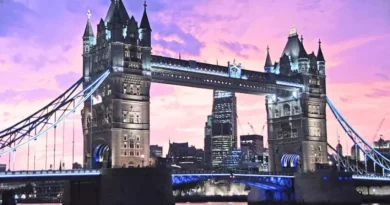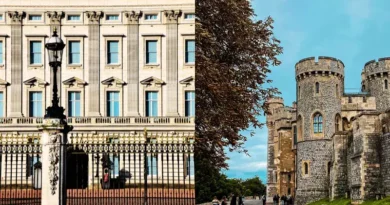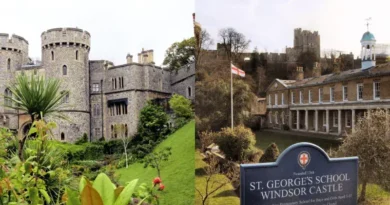Are There Toilets at Windsor Castle?
Yes, there are toilets available at Windsor Castle for visitors. These facilities, which include baby care and accessible toilets, are located after the Security Hall near the start of the visit, on the North Terrace before the entrance to the State Apartments, and next to the Undercroft Café. For accessible toilets, a RADAR key is required; staff can assist if visitors do not have their key. A Changing Places facility is also available on Engine Court, with staff available to provide directions.
Key Takeaways
| Key Takeaway |
|---|
| Windsor Castle offers modern toilet facilities for visitors, including accessible toilets and baby care facilities. |
| These facilities are located after the Security Hall, on the North Terrace before the State Apartments, and next to the Undercroft Café. |
| A Changing Places facility is available on Engine Court. |
| While modern facilities are available, the castle’s custodians balance this with the need to preserve its historical fabric. |
| Historically, sanitation at Windsor Castle evolved from chamber pots and garderobes to more sophisticated systems, reflecting advancements in technology. |
| Garderobes served a dual purpose: as toilets and for storing clothes (the ammonia was thought to deter moths). |
| Public toilets are conveniently located and clearly signposted for visitors. |
| Staff are available to assist visitors with directions and any other queries. |
| Windsor Castle is committed to accessibility, providing disabled toilets and other necessary adaptations. |
| Separate, private toilet facilities likely exist for the royal family and staff, though details are not publicly disclosed for privacy and security reasons. |
| Official maps and guides, as well as staff assistance, can help visitors locate toilet facilities. |
| Free public toilets are available in Windsor town at Windsor & Eton Central Station and the Victoria Street Car Park. |
| The evolution of sanitation at Windsor Castle reflects broader societal advancements in hygiene and technology. |
The Burning Question
Does Windsor Castle Have Modern Toilets?
Visitors to Windsor Castle, one of the most iconic and historic royal residences in the United Kingdom, often wonder about the availability and modernity of essential facilities like toilets. This section delves into whether Windsor Castle is equipped with modern toilets, exploring evidence for and against this proposition.
1. Evidence for Modern Toilets: Upgrades and Accessibility
Windsor Castle has undergone numerous upgrades and renovations to improve the visitor experience. These enhancements include the installation of modern toilets designed to meet contemporary standards of comfort and accessibility. According to official sources, public amenities within the castle grounds are regularly updated to ensure they are functional and convenient for all visitors, including those with disabilities.
Implementing modern sanitation facilities is evident in various parts of the castle. Public restrooms are strategically located to serve the high volume of daily tourists. These facilities have standard features such as flush toilets, sinks with running water, and hand dryers, ensuring visitors can access clean and efficient amenities.
2. Evidence Against Modern Toilets: Historical Preservation
Despite modern toilets, arguments suggest that certain areas of Windsor Castle may retain historical elements that limit the extent of contemporary modifications. Windsor Castle is a tourist attraction and a working royal residence with significant historical and architectural value. Preservation of its authenticity sometimes necessitates minimal alterations to certain structures.
Some sections of the castle, particularly those not frequently accessed by the public, may have fewer modern amenities due to the need to maintain their historical integrity. The balance between providing modern comforts and preserving the historical fabric of the castle is a constant challenge faced by the custodians of this ancient site.
A Historical Look at Toilets

What Did They Use in the Past at Windsor Castle?
Understanding the historical context of sanitation at Windsor Castle provides valuable insights into how modern facilities have evolved. This section examines the types of toilets used in the past and their evolution in royal residences.
1. Chamber Pots and Garderobes
In the earlier days of Windsor Castle, modern plumbing was nonexistent. Instead, chamber pots and garderobes were commonly used. Chamber pots were simple containers kept in rooms for nighttime use, later emptied by servants. Conversely, Garderobes were more permanent structures, often within castle walls, allowing waste to fall into a cesspit or moat below.
These primitive sanitation methods were typical in medieval castles and represented the best available technology. The term “garderobe” itself hints at its dual purpose; besides serving as a toilet, it was often used to store clothes, as the ammonia from the waste was believed to deter moths.
2. The Evolution of Sanitation in Royal Residences
The advancement of sanitation technology gradually improved the living conditions within royal residences like Windsor Castle. Introducing more sophisticated waste disposal systems, such as rudimentary plumbing and modern sewage systems, marked significant progress. By the Victorian era, flushing toilets and running water became more common in royal households, reflecting broader trends in urban sanitation improvements.
These enhancements improved hygiene and contributed to the comfort and convenience of residents and visitors alike. The transition from chamber pots to flush toilets represents a significant leap in the quality of life within these historic walls.
Public vs. Private Facilities
Are There Toilets Available for Visitors?
Windsor Castle welcomes millions of visitors each year, necessitating the provision of adequate toilet facilities. This section explores the availability, location, and accessibility of toilets for the public, as well as the distinctions between public and private facilities.
1. Location and Accessibility of Public Toilets
Public toilets at Windsor Castle are conveniently located to ensure visitors have easy access during their tour. These facilities are near key areas such as the entrance, State Apartments, and St. George’s Chapel. Clear signage throughout the castle grounds directs visitors to the nearest restrooms, ensuring they are easily found without disrupting the tour flow.
Accessibility is a key consideration in the placement of these facilities. Many public toilets are designed to accommodate individuals with disabilities, featuring wide doors, grab rails, and other necessary adaptations. This inclusivity ensures that all visitors can comfortably enjoy their visit regardless of physical ability.
2. Variations in Toilets Across Different Areas of the Castle
The quality and style of toilets vary depending on their location within Windsor Castle. For instance, restrooms near the main entrance and State Apartments tend to be more modern and spacious, reflecting these areas’ high traffic and importance. In contrast, facilities in less frequented parts of the castle, such as certain gardens or remote sections, might be simpler but still functional.
Additionally, toilets within commercial areas like gift shops and cafés are maintained to high standards, offering visitors a clean and pleasant experience. The attention to detail in these amenities highlights the commitment to providing a comfortable visit for all guests.
Do Staff and Royals Have Separate Toilets?
An interesting aspect of Windsor Castle’s facilities is the potential distinction between public and private toilets used by staff and royal family members. This section examines theories about the locations and privacy of these exclusive facilities.
1. Theories on Locations of Private Toilets
While specific details about the private facilities used by the royal family and staff are not publicly disclosed for security and privacy reasons, it is reasonable to infer that these amenities are strategically placed within private quarters. Areas like the Upper Ward, where the royal apartments are located, likely feature more exclusive and discreet toilets.
These private facilities are expected to be more luxurious and spacious, catering to the needs of the royal family and high-ranking staff members. The exact locations and specifications remain closely guarded, maintaining the privacy and security of the residents.
2. Privacy Concerns and Discretion
Privacy is paramount regarding the amenities used by the royal family and their staff. Discretion is maintained in these facilities’ design location and daily use. The need to balance public access with private comfort and security is a key consideration in the management of Windsor Castle.
The existence of separate facilities for different groups within the castle underscores the importance of maintaining a respectful and functional environment for visitors and residents.
Planning Your Visit

Where Can You Find Toilets During Your Tour?
Knowing the locations of essential facilities like toilets can enhance the overall experience when planning a visit to Windsor Castle. This section provides practical advice on finding these amenities during your tour.
1. Using Official Maps and Guides
Official maps and guides provided at the entrance of Windsor Castle are invaluable resources for visitors. These materials mark the locations of public toilets, helping visitors plan their route and avoid any inconvenience. Staff at the entrance often provide these guides and additional tips on navigating the castle grounds efficiently.
Utilizing these resources ensures that visitors are well-informed and can focus on enjoying the castle’s historical and cultural offerings without worrying about necessities.
2. Asking Staff for Assistance
Castle staff are always available to assist visitors with any queries, including the whereabouts of toilets. They are knowledgeable and courteous, ready to provide directions and advice on the nearest facilities. This personal touch can greatly enhance the visitor experience, ensuring that any issues are promptly addressed.
Accessibility Considerations for Toilets
Ensuring that toilet facilities are accessible to all visitors, including those with disabilities, is a priority at Windsor Castle. This section discusses the availability of disabled toilets and tips for planning a visit to avoid potential emergencies.
1. Availability of Disabled Toilets
Windsor Castle is committed to inclusivity, with disabled toilets available in several key locations. These facilities are designed to be spacious and equipped with features such as grab rails and lowered sinks, making them suitable for visitors with mobility challenges. Information on the availability and location of these toilets is included in the official guides and maps provided at the entrance.
2. Planning for Long Tours and Avoiding Emergencies
Given the extensive grounds and numerous attractions within Windsor Castle, planning for long tours is essential. Visitors are advised to take note of toilet locations before starting their tour to avoid potential emergencies. Regular breaks to use the facilities can ensure a comfortable and enjoyable visit.
Beyond the Toilets
Interesting Facts About Toilets and Sanitation in Royal Palaces
Toilets and sanitation at Windsor Castle are not only functional aspects but also part of its rich history. This section explores some interesting facts and modern practices related to sanitation in royal palaces.
1. Historical Anecdotes and Misconceptions
Historically, royal palaces like Windsor Castle have been associated with various myths and misconceptions regarding sanitation. For instance, it was once believed that garderobes, besides their sanitary function, were used to protect clothes from moths due to the ammonia from the waste. Such anecdotes provide a fascinating glimpse into the past practices and beliefs surrounding sanitation.
2. Modern Sanitation Practices at Windsor Castle
Windsor Castle employs modern sanitation practices that reflect contemporary hygiene and efficiency standards. These include regular maintenance and cleaning schedules, environmentally friendly cleaning products, and adherence to health and safety regulations. Integrating these practices ensures all visitors have a pleasant experience while preserving the castle’s historical charm.
Conclusion
Windsor Castle blends historical preservation with modern convenience, offering well-maintained and strategically located toilet facilities. These amenities ensure comfort for millions of visitors annually and reflect the castle’s commitment to enhancing the guest experience while honouring its rich heritage. The evolution of sanitation within the castle mirrors societal advancements, providing a subtle yet meaningful connection between the past and present. As visitors explore this iconic landmark, these thoughtfully placed facilities contribute to an uninterrupted and immersive journey through centuries of history.
FAQ
Where are the toilets located within Windsor Castle?
Toilets are available after the Security Hall near the start of your visit, on the North Terrace before the entrance to the State Apartments, and next to the Undercroft Café.
Are there accessible toilets for disabled visitors?
Yes, accessible toilets are available in the same locations as standard toilets. They are locked with a RADAR key; ask a staff member for assistance if you don’t have one.
Is there a Changing Places facility at Windsor Castle?
Yes, a Changing Places facility is available on Engine Court. Please ask a member of staff for directions.
Are baby-changing facilities available?
Yes, baby-care facilities are located near the toilets after the Security Hall, on the North Terrace, and next to the Undercroft Café.
Is there a café with toilet facilities in the castle?
Yes, the Undercroft Café offers toilet facilities nearby, including accessible and baby-care amenities.
Can I use a pushchair around the castle grounds?
Pushchairs can be used around the grounds but must be checked in at the cloakroom before entering indoor areas. Baby carriers and hip seats are free of charge, subject to availability.
Is there a water fountain for refilling bottles?
Yes, a water fountain is available in the outdoor area after exiting the Security Hall.
Are there free public toilets in Windsor town?
Yes, free public toilets are available at Windsor & Eton Central Station and the Victoria Street Car Park, opposite William Street.
Is breastfeeding allowed within Windsor Castle?
Yes, breastfeeding is welcome anywhere within the castle.
Are there any restrictions on eating and drinking inside the castle?
Eating and drinking are prohibited except for bottled water in the State Apartments or St George’s Chapel.
Is there a cloakroom available for visitors?
Yes, a cloakroom is available to check items like pushchairs before entering indoor areas.
Are there any facilities for visitors with mobility issues?
Windsor Castle is fully accessible, with concessionary rates for visitors with disabilities and free admission for a companion. Accessible toilets and a Changing Places facility are available.
Can I borrow a baby carrier at Windsor Castle?
Yes, baby carriers and hip seats can be borrowed free of charge, subject to availability.
Is there an accessible café within the castle?
Yes, the Undercroft Café is accessible and offers a range of refreshments.
Are there any facilities for visitors with hearing impairments?
The multimedia guide is available in British Sign Language (BSL) and with subtitles.
Are there Bathrooms at Windsor Castle?
Yes, Windsor Castle offers modern, well-maintained restrooms for visitors, including accessible facilities equipped with contemporary amenities. These restrooms are conveniently located throughout the castle grounds to ensure visitor comfort.









